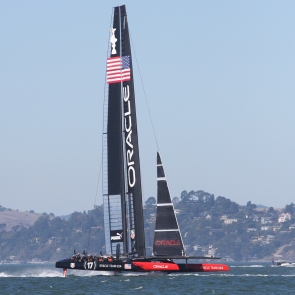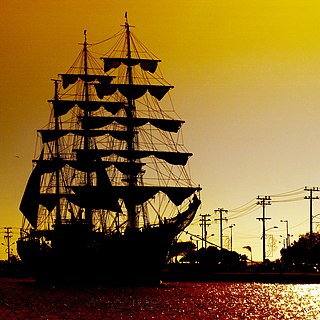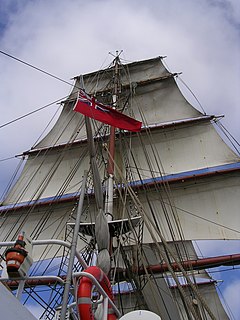
Sailing employs the wind—acting on sails, wingsails or kites—to propel a craft on the surface of the water, on ice (iceboat) or on land over a chosen course, which is often part of a larger plan of navigation.

Solar sails are a proposed method of spacecraft propulsion using radiation pressure exerted by sunlight on large mirrors. A useful analogy may be a sailing boat; the light exerting a force on the mirrors is akin to a sail being blown by the wind. High-energy laser beams could be used as an alternative light source to exert much greater force than would be possible using sunlight, a concept known as beam sailing.

A sloop is a sailing boat with a single mast and a fore-and-aft rig. A sloop has only one head-sail; if a vessel has two or more head-sails, the term cutter is used, and its mast may be set further aft than on a sloop.
A schooner is a type of sailing vessel with fore-and-aft sails on two or more masts. The most common type has two masts, the foremast being shorter than the main. While the schooner was originally gaff-rigged, modern schooners typically carry a Bermuda rig.

A sailing ship is a large watercraft that uses sails to harness the power of wind. A "ship-rigged" sailing ship carries three or more masts with square sails on each. Other large sailing vessels, that are not ship-rigged, may be more precisely referred to by their sail rig, such as schooner, barque, brig, barkentine, brigantine or sloop.

A sailboat or sailing boat is a boat propelled partly or entirely by sails smaller than a sailing ship. Distinctions in what constitutes a sailing boat and ship vary by region and maritime culture.

A sail plan is a set of drawings, usually prepared by a naval architect which shows the various combinations of sail proposed for a sailing ship. Alternatively, as a term of art, it refers to the way such vessels are rigged as discussed below.

A brig is a sailing vessel with two square-rigged masts. During the Age of Sail, brigs were seen as fast and maneuverable and were used as both naval warships and merchant vessels. They were especially popular in the 18th and early 19th centuries. Brigs fell out of use with the arrival of the steam ship because they required a relatively large crew for their small size and were difficult to sail into the wind. Their rigging differs from that of a brigantine which has a gaff-rigged mainsail, while a brig has a square mainsail with an additional gaff-rigged spanker behind the mainsail.
A jib is a triangular sail that sets ahead of the foremast of a sailing vessel. Its tack is fixed to the bowsprit, to the bows, or to the deck between the bowsprit and the foremost mast. Jibs and spinnakers are the two main types of headsails on a modern boat.

Windsurfing is a surface water sport that combines elements of surfing and sailing. It consists of a board usually 2 to 2.5 metres long, with displacements typically between 45 and 150 litres, powered by wind on a sail. The rig is connected to the board by a free-rotating universal joint and consists of a mast, boom and sail. On “short” boards The sail area generally ranges from 1.5 to 12 square metres depending on the conditions, the skill of the sailor, the type of windsurfing being undertaken and the weight of the person windsurfing. On long boards, upon which the sport was first popularized -sail areas and board lengths are typically larger and the athleticism required is much less.

A mainsail is a sail rigged on the main mast of a sailing vessel.

A lateen or latin-rig is a triangular sail set on a long yard mounted at an angle on the mast, and running in a fore-and-aft direction.

Square rig is a generic type of sail and rigging arrangement in which the primary driving sails are carried on horizontal spars which are perpendicular, or square, to the keel of the vessel and to the masts. These spars are called yards and their tips, beyond the last stay, are called the yardarms. A ship mainly so rigged is called a square-rigger.

A full-rigged ship or fully rigged ship is a sailing vessel's sail plan with three or more masts, all of them square-rigged. A full-rigged ship is said to have a ship rig or be ship-rigged.

Full Sail University is a private, for-profit university in Winter Park, Florida. It was formerly a recording studio in Ohio named Full Sail Productions and Full Sail Center for the Recording Arts. Full Sail moved to Florida in 1980, running video and film production courses. It began offering online degrees in 2007. The school is partly owned by TA Associates, a private equity firm.

A smack was a traditional fishing boat used off the coast of Britain and the Atlantic coast of America for most of the 19th century and, in small numbers, up to the Second World War. Many larger smacks were originally cutter-rigged sailing boats until about 1865, when smacks had become so large that cutter main booms were unhandy. The smaller smacks retain the gaff cutter rig. The larger smacks were lengthened and re-rigged and new ketch-rigged smacks were built, but boats varied from port to port. Some boats had a topsail on the mizzen mast, while others had a bowsprit carrying a jib.
Windmills are powered by their sails. Sails are found in different designs, from primitive common sails to the advanced patent sails.
LightSail is a project to demonstrate controlled solar sailing using CubeSat artificial satellites developed by The Planetary Society, a global non-profit organization devoted to space exploration. The spacecraft core measures 10 × 10 × 30 cm, and its kite-shaped solar sail deploys into a total area of 32 square meters (340 sq ft).

Black Sails is an American historical adventure television series set on New Providence Island and a prequel to Robert Louis Stevenson's novel Treasure Island. The series was created by Jonathan E. Steinberg and Robert Levine for Starz. It debuted online for free on YouTube and other various streaming platform and video on demand services on January 18, 2014. The debut on cable television followed a week later on January 25, 2014. Steinberg is executive producer, alongside Michael Bay, Brad Fuller and Andrew Form, while Michael Angeli, Doris Egan, and Levine are co-executive producers.

A sail is a tensile structure—made from fabric or other membrane materials—that uses wind power to propel sailing craft, including sailing ships, sailboats, windsurfers, ice boats, and even sail-powered land vehicles. Sails may be made from a combination of woven materials—including canvas or polyester cloth, laminated membranes or bonded filaments—usually in a three- or four-sided shape.

















